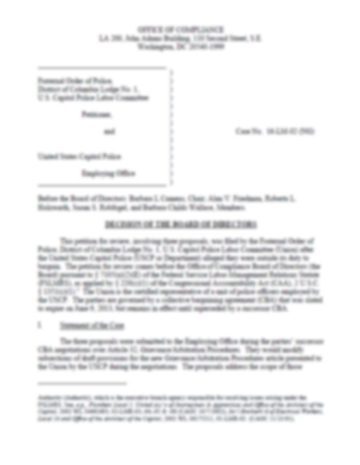DECISION OF THE BOARD OF DIRECTORS
By its decision and order dated December 7, 2005, the Board of Directors (“Board”) remanded this matter with instructions to the hearing officer.1 On March 7 and 8, 2006, Hearing Officer Michael Doheny held a hearing pursuant to the remand and subsequently issued his dispositive decision, holding that Petitioner failed to establish a prima facie case of retaliation in Counts I and II. Hearing Officer Doheny also found that as a result of Petitioner’s failure to meet his burden in Counts I and II, he could not establish a hostile work environment based on the alleged retaliatory conduct, as pled in Count III.
Upon due consideration of the hearing officer’s decision and order, and the parties filings, the Board affirms the hearing officer’s determination of no discrimination. With respect to Counts I and III, the Board is satisfied that the hearing officer’s decision is supported by substantial record evidence and that the hearing officer employed the correct legal principles and analyses in reaching his result.
With respect to Count II, the Board agrees with the hearing officer’s conclusion that the evidence presented did not support an inference of discrimination. Specifically, the Board agrees with the hearing officer’s determination that there was insufficient evidence to establish a causal connection between Petitioner’s protected activity and Architect Hantman’s lack of response to Petitioner’s formal grievance: Petitioner failed to present any evidence of disparate treatment, and the hearing officer determined that there was no causal connection between the activity and the alleged wrongful act. The Board finds this determination to be supported by the evidence.
The Board does not adopt, however, the hearing officer’s rationale that because Petitioner continued with his protected activity, the AOC’s actions amounted to a “petty slight” or a “trivial annoyance” and were not “reasonably likely to deter” protected activity. In Britton v. Office of the Architect of the Capitol, 02-AC-20 (CV, RP)(May 23, 2005), the Board explained its “reasonably likely to deter” standard:
Our adoption of a more flexible definition of adverse action should not be understood as invitation to transform the CAA into a ‘civility code’. The essence of Section 207 is the prevention of employer conduct that chills legitimate opposition to unlawful practices. An adverse action will not be established merely because the employee dislikes the employing office’s action or disagrees with it. While our ‘reasonably likely to deter’ test may be more flexible than the ‘ultimate employment action’ and ‘material adverse action’ requirement used by some courts in the Title VII context, it is intended to exclude petty slights, trivial annoyances and anything that is not reasonably likely to deter employees from engaging in protected activity.
Britton, p.9. The Board takes issue with the hearing officer’s rationale that Hantman’s lack of response fails to amount to an adverse action under Britton simply because Petitioner continued with his protected activity. Such rationale broadly precludes any employee who continues with protected activity from making a claim of retaliation. Britton does not stand for such broad preclusion, and the Board differs from the hearing officer in this respect. As such, the Board cannot adopt this portion of the hearing officer’s decision.
However, because the hearing officer separately determined that no causation exists, and because the record evidence supports this determination, there exists substantial evidence to support the hearing officer’s overall ruling on Count II.2 Thus, it is of no consequence that the Board disagrees with the portion of the hearing officer’s rationale relating to “petty slights” and “trivial annoyances.”
ORDER
Pursuant to Section 406(e) of the Congressional Accountability Act and Section 8.01(d) of the Office of Compliance Procedural Rules, the Board affirms the hearing officer’s merits determination of no retaliation and no hostile work environment.
It is so ORDERED.
Issued, Washington, D.C.
January 19, 2007
CERTIFICATE OF SERVICE
I HEREBY CERTIFY that a copy of the foregoing Decision of the Board of Directors was provided to the parties via first-class mail on the 19th of January, 2007, and was served by hand-delivery on the dates below:
FOR PICK UP ON JANUARY 19, 2007
Jeffrey Leib, Esq.
5104 34th Street, NW
Washington, D.C. 20008
FOR ANTICIPATED PICK UP ON JANUARY 19, 2007
John Clifford, Esq.
Clifford & Garde
1707 L Street, N.W.
Suite 500
Washington, D.C. 20036-5631
Respectfully submitted,
Selviana B. Bates
Hearing Clerk
1 The Board held that the hearing officer erred in his analysis of adverse employment action. The Board relied on its ruling in Britton v. Office of the Architect of the Capitol, 02-AC-20 (CV, RP)(May 23, 2005), where the Board adopted the less restrictive standard of “reasonably likely to deter” over the more restrictive “ultimate employment action” standard. The Board also held that the hearing officer’s determination of insufficiency of the evidence, which was based on the pleadings, was prematurely made.
2 Because the Board agrees with the hearing officer’s finding of no causal connection between the protected. activity and the alleged adverse action in this case, we find it unnecessary to address in this decision the effect, if any, of the Supreme Court’s ruling in Burlington v. Northern and Santa Fe Railway Co. v. White, 126 S.Ct. 2405 (June 22, 2006) on retaliation claims under the CAA.
